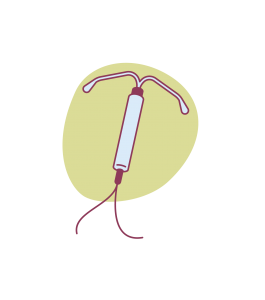
Join 1,000s of women in our pause. community
Get valuable information and support from our community and team of menopause specialists. Subscribe for the latest evidence-based information, free events, helpful articles and inspiring women’s stories.
Downloaded from www.mymenopausecentre.com
Direct URL: https://www.mymenopausecentre.com/gp-resources/mirena-information-sheet/
Your doctor may have talked to you about whether a Mirena™ intrauterine system is right for you. Here’s some information about it, what it does, the advantages and disadvantages.

The Mirena™ intrauterine system (you may also know it as a ‘hormone coil’) is a small T-shaped, plastic device that is fitted into the womb. There are different types of intrauterine systems, but the Mirena™ is particularly useful. This is because, in addition to it being a form of contraception, it can also be used as part of your hormone replacement therapy (HRT).
HRT consists of two hormones – oestrogen and progestogen. Oestrogen manages most menopause symptoms, and progestogen protects the lining of the womb. That’s because if you still have a womb (you haven’t had a hysterectomy) and you take oestrogen by itself, it can thicken the lining of your womb, increasing your risk of womb cancer. Progestogen prevents the lining of your womb from thickening.
Once a Mirena™ has been fitted, it lasts for 5 years (this use is outside its product license – but is used in line with guidance from the Faculty of Sexual and Reproductive Healthcare). If you have a Mirena™ fitted, you only need to take oestrogen, which can come in a patch, gel, spray, or tablet.
Many GPs and nurses fit Mirena™ and you can usually get this done at your GP practice or a local sexual health clinic. Before you have the Mirena™ fitted, you need to make sure that you aren’t pregnant and/or don’t have any sexually transmitted infections (STIs). If you’re at risk of an STI, the nurse or doctor will take a swab, or you may be given antibiotics at the time of fitting.
Having a Mirena™ fitted takes around 5-10 minutes, though your appointment will usually be longer than that.
You can sometimes (but not always) experience intense, short-lasting period-like pains during fitting, and you may get some period-like cramps over the next few days.
A doctor or nurse will first examine you internally and then use a speculum to see the cervix (this feels a bit like having a smear).
The Mirena™ comes folded in a slim ‘introducer’, which is passed through the neck of the womb (cervix) and released into the cavity. Two thin threads are left hanging into the vagina. A medical professional uses the threads to remove the coil. You may be able to check the threads are present – particularly initially, but with time the threads curl over the neck of the womb and so you may not be able to feel them. Your partner should not be able to feel the threads during sex. If they are felt during sex, please see a doctor or nurse to check the fitting and trim the threads if needed.
If you’ve had a Mirena™ fitted, you should always see a doctor if you develop a fever, abnormal or offensive vaginal discharge (as a sign of infection), pelvic pain, abnormal vaginal bleeding (more than the expected frequent spotting), if you suspect pregnancy or if you cannot feel the threads, or you can feel the hard plastic stem of the Mirena™ in the vagina.
For more information:
If you would like a Mirena™ fitted, the best first port of call would be your GP practice or local sexual health clinic.
Dr Clare Spencer
Registered menopause specialist, GP and co-founder; see Dr Clare in person at The Spire Hospital, Leeds or online
07/04/2021
We’ve created pause. as a space for women to come together and share stories about their menopause experience, ask questions, and to find support and inspiration. We'll also share the latest news and updates on the menopause from our experts.
Share your email to receive the latest news, updates and information on new products and treatments from My Menopause Centre and our pause. community. You can unsubscribe at any time.
We're committed to protecting and respecting your privacy - see our Privacy Policy and Terms and Conditions

Whether you want to discuss your symptoms, create a treatment plan that's right for you, understand some test results or have a check-up, the highly experienced doctors and nurses in our menopause clinic are here to help you.
Book now